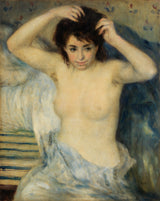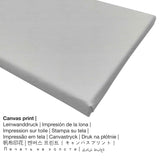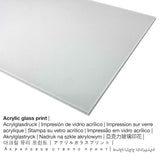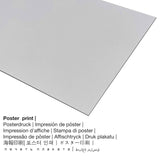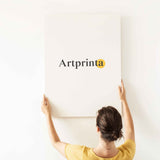Pierre-Auguste Renoir, 1875 - Before the Bath (Avant le bain) - fine art print
Tax included. Shipping calculated at checkout.
Summarization of the replica
This modern art masterpiece called Before the Bath (Avant le bain) was made by the French painter Pierre-Auguste Renoir in 1875. The over 140 years old original has the following size: Overall: 32 5/16 x 26 3/16 in (82 x 66,5 cm). Oil on canvas was applied by the artist as the medium of the piece of art. This artwork is part of the Barnes Foundation's collection. With courtesy of Courtesy of the Barnes Foundation, Merion and Philadelphia, Pennsylvania (license - public domain).: . Besides, the alignment of the digital reproduction is portrait and has a ratio of 1 : 1.2, which implies that the length is 20% shorter than the width. The illustrator, painter, sculptor Pierre-Auguste Renoir was a European artist, whose art style can be attributed mainly to Impressionism. The European painter was born in the year 1841 in Limoges, Nouvelle-Aquitaine, France and deceased at the age of 78 in the year 1919 in Cagnes-sur-Mer, Provence-Alpes-Cote d'Azur, France.
Additional description by Barnes Foundation (© - Barnes Foundation - Barnes Foundation)
Before the Bath is one of 19 paintings Renoir offered for sale in a scandalous public auction at Hotel Drouot on March 23–24, 1875. Organized by Galerie Durand-Ruel, the auction included new works by Renoir, Monet, Morisot, and Sisley; so controversial were the canvases on view that the public became almost violent. As Paul Durand-Ruel recalled years later, the sale "provoked incredible scenes. The day of the viewing and during the sale, [we] had to call the police in order to prevent small altercations from degenerating into full-fledged battles. The public, incensed by the rare supporters, wanted to stop the sale and howled at each bid". It is hard to imagine that a subtle painting like Before the Bath at one time provoked fistfights. At first glance, it has little of the radicalism of a work such as Study, Nude in Sunlight (Musée d'Orsay), another half-length nude that would cause uproars at the 1876 impressionist exhibition for its bold colors and disruptive splotches of sunlight playing across the flesh. Here, indoors, Renoir's focus is on the body itself rather than on the play of light across it. The moment presented is a private one: the figure undresses for bathing, the shallow space and up-close focus adding to the feeling of intimacy. Her raised arms form a perfect triangular frame around her face, which wears a serene expression. The palette is fairly subdued and the modeling of the figure's torso is strong, with subtle tonal modulations producing rounded forms, especially in the arms and under the breasts. With her sculpted forms and falling garment, she evokes such classical sculpture as the Venus de Milo.This evocation may be precisely what offended about the picture. For superimposed onto this classical frame are signs of the everyday. The hair is unkempt, and rumpled bedcovers can be glimpsed in the background. The raised arms reveal hair in the armpits—a detail which audiences in 1875 were not accustomed to seeing—and the facial features, while attractive, are not idealized: she looks too much like an ordinary Parisian woman. Theodore Duret wrote admiringly about this aspect of Renoir's nudes: "Instead of looking up to beings which represented human nature as perfectly beautiful, he was looking at ordinary creatures, his women were such as one could meet anywhere, he had made no selection." Indeed, it was Duret who had purchased the painting at the 1875 sale, through Henri Hecht, for the small sum of 140 francs. Yet Duret's enthusiasm was hardly typical; for most viewers the painting must have seemed a strange confusion of the real and the ideal.While the painting has the voyeuristic feel of having entered into this woman's private space, we know very well that Renoir set up this scenario in his studio. The patterned wallpaper in the background is from his apartment in the rue Saint-Georges, and can be seen also in the portrait of Jeanne Durand-Ruel (BF950). The model is possibly Henriette Henriot, who posed for so many of Renoir's pictures around this time; see Parisienne (National Museum Wales). Though the hair on this model is darker than the notorious red mane seen in other representations of Henriot, the face, especially the nose and mouth, is strikingly similar to her appearance in Parisienne. By the time Before the Bath was featured in a 1912 exhibition in Durand-Ruel's New York gallery, it was one of Renoir's most celebrated works. Critics such as Octave Mirbeau had earlier praised its "strong drawing," calling it "one of the best pieces of modern painting." Durand-Ruel, who had purchased the painting at the Duret sale in 1894, marveled over the increase in its value over the course of a few decades. Barnes went several times to New York to see the Renoirs in the 1912 exhibition. Struck by this picture in particular, he inquired about its price, only to be told in a letter from one of the Durand-Ruel sons that it was not for sale. Barnes succeeded in securing the picture a few weeks later, in April 1912, much to the delight of American critics such as James Huneker, who raved about its "glowing, nacreous flesh tones [and] its admirable modeling" in the New York Sun. "Luckily," he continued, "the canvas is now in the collection of an American not many hours from New York." Martha Lucy, Renoir in the Barnes Foundation (New Haven: Yale University Press, 2012), 76-77.
Structured information on the piece of art
| Artpiece title: | "Before the Bath (Avant le bain)" |
| Classification of the artpiece: | painting |
| Art classification: | modern art |
| Time: | 19th century |
| Created in the year: | 1875 |
| Artwork age: | more than 140 years old |
| Original medium of artwork: | oil on canvas |
| Dimensions of the original work of art: | Overall: 32 5/16 x 26 3/16 in (82 x 66,5 cm) |
| Museum / location: | Barnes Foundation |
| Museum location: | Philadelphia, Pennsylvania, United States of America |
| Available under: | Barnes Foundation |
| License: | public domain |
| Courtesy of: | Courtesy of the Barnes Foundation, Merion and Philadelphia, Pennsylvania |
Artist summary table
| Name of the artist: | Pierre-Auguste Renoir |
| Additional names: | renoir p.a., Pierre Auguste Renoir, Renoir Pierre-Auguste, Renuar Ogi︠u︡st, רנואר פייר אוגוסט, Renoir August, Renoir Auguste, p.a. renoir, renoir a., firmin auguste renoir, a. renoir, Renoir Pierre Auguste, Renoir Pierre August, Renoar Pjer-Ogist, רנואר אוגוסט, August Renoir, Auguste Renoir, Renoir, pierre august renoir, Pierre-Auguste Renoir |
| Gender: | male |
| Artist nationality: | French |
| Professions of the artist: | sculptor, illustrator, painter |
| Country of origin: | France |
| Artist category: | modern artist |
| Art styles: | Impressionism |
| Age at death: | 78 years |
| Year born: | 1841 |
| Town of birth: | Limoges, Nouvelle-Aquitaine, France |
| Year died: | 1919 |
| Town of death: | Cagnes-sur-Mer, Provence-Alpes-Cote d'Azur, France |
Get your favorite product material
We offer a range of different sizes and materials for every product. We allow yout to choose among the following variants:
- Print on acrylic glass (with real glass coating): The print on acrylic glass, often referenced as a UV print on plexiglass, will turn the original into gorgeous wall décor and is a good alternative to aluminium and canvas fine art prints.
- Poster (canvas material): The poster is a UV printed sheet of flat canvas paper with a nice surface finish, that resembles the original masterpiece. It is ideally suited for putting the art print in a customized frame. Please note, that depending on the size of the poster we add a white margin of something between 2-6cm around the print, which facilitates the framing with a custom frame.
- Aluminium dibond: This is a metal print manufactured on aluminium dibond with an outstanding depth effect. The non-reflective surface structure make a fashionable impression. The Direct Print on Aluminum Dibond is your excellent start to the sophisticated world of art replicas on aluminum.
- Canvas: The printed canvas material stretched on a wood frame. The advantage of canvas prints is that they are relatively low in weight, meaning that it is easy and straightforward to hang up the Canvas print without additional wall-mounts. A canvas print is suitable for all types of walls.
Structured item details
| Product classification: | fine art print |
| Reproduction: | reproduction in digital format |
| Manufacturing method: | UV direct printing (digital print) |
| Origin of the product: | Germany |
| Type of stock: | on demand production |
| Proposed product use: | wall art, art collection (reproductions) |
| Orientation of the image: | portrait format |
| Side ratio: | 1 : 1.2 length to width |
| Image aspect ratio interpretation: | the length is 20% shorter than the width |
| Materials you can select: | canvas print, metal print (aluminium dibond), poster print (canvas paper), acrylic glass print (with real glass coating) |
| Canvas print (canvas on stretcher frame) size variants: | 50x60cm - 20x24", 100x120cm - 39x47", 150x180cm - 59x71" |
| Acrylic glass print (with real glass coating) sizes: | 50x60cm - 20x24", 100x120cm - 39x47" |
| Poster print (canvas paper): | 50x60cm - 20x24", 100x120cm - 39x47" |
| Aluminium print (aluminium dibond material) size options: | 50x60cm - 20x24", 100x120cm - 39x47" |
| Art print framing: | not included |
Important legal note: We try whatever we can in order to depict our products as accurately as it is possible and to exhibit them visually in our shop. Still, the pigments of the printed materials, as well as the print result might differ slightly from the presentation on the monitor. Depending on the settings of your screen and the nature of the surface, colors might not be printed one hundret percent realistically. Since all our art reproductions are printed and processed by hand, there might also be slight deviations in the exact position and the size of the motif.
This text is protected by copyright © - www.artprinta.com (Artprinta)

